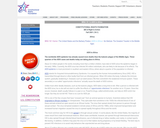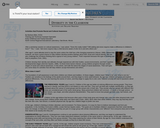
This resource provides instructional strategies for teaching chronological narratives.
- Subject:
- Social Studies
- Material Type:
- Activity/Lab
- Provider:
- Tarr's Toolbox
- Date Added:
- 08/17/2017

This resource provides instructional strategies for teaching chronological narratives.

In this lesson, students are introduced to the importance of consumerism in the 1920s and recognize the connections between commodities and culture in the American past and present.

In this activity, students examine an advertisement from 1847 and answer a series of questions. The questions are designed to guide students into a deeper analysis of the source and sharpen associated cognitive skills.

This jeopardy style interactive reviews social studies content.

This resource provides information on the three branches of government and contains two videos about the constitution.

This presentation teaches students about the branches of government at the state level and how they check and balance each other.

This resource explains how the Romans established a form of government-a republic-that was copied by countries for centuries and how the United States is based partly on Rome's model.

In this lesson, students will read and analyze an Alphabet Book for Young Citizens to reinforce their understandings of the distinctions between a right, a responsibility, and a provilege. They will then use the pages in their books to create a Citizen's Bulletin Board, an exhibit on citizenship, and civic improvisations that provide students with opportunities to deepen and apply their understandings. Students will begin exercising their rights and responsibilities with a better understanding of how such actions help secure their liberties and freedom.

This book is to be used with the lesson "The ABCs of Citizenship." In this lesson, students will read and analyze the Alphabet Book for Young Citizens to reinforce their understandings of the distinctions between a right, a responsibility, and a privilege. They will then use the pages in their books to create a Citizen's Bulletin Board, an exhibit on citizenship, and civic improvisations that provide students with opportunities to deepen and apply their understandings. Students will begin exercising their rights and responsibilities with a better understanding of how such actions help secure their liberties and freedom.

In this lesson, students read about the worldwide AIDS epidemic and the prevalence of AIDS in Africa. A set of discussion questions is provided. In an associated activity, students will consider various options of how the U.S. could react to the AIDS crisis in Africa. Student groups will discuss the options and then role play a State Department meeting on the question of what to do.

In this curriculum unit, students will explore the question: What was life, particularly the writing life, like for an American woman before, during, and after the founding of our nation? Using Abigail Adams's correspondence and diaries, students will explore primary source documents to learn about the historical, cultural, and ethical role of women in early America. Students will analyze the works of Mrs. Adams and other women, create a diary as if they lived during the time period, write essays comparing their lives to that of an 18th century New Englander, and produce a historical film containing scenes from the life of Mrs. Adams. The unit includes transcribed primary sources, numerous worksheets, and detailed homework assignments.

In this four lesson unit, students use primary source materials to gain insight and perspective about what it was like to live in the past.

In this lesson, students will: 1. Review and understand multiple perspectives of slavery (the slaves' point of view, the abolitionist point of view and the view of the slave holder). 2. Learn three abolitionist leaders and their contribution to the movement against slavery. 3. Read and interpret primary documents having to do with the abolitionist movement. 4. Demonstrate understanding of primary documents through written assessment.

Resources provides information about Rivtak, a business created by an North Carolina native.

In this activity, students will complete a close reading of the Gettysburg address by using the strategy called SOAPSTONE.

In this lesson, students participate in a puzzle activity to identify leadership characteristics that Abraham Lincoln possessed. They review the changes in the $5 note and consider how Lincoln's leadership characteristics contribute to the fact that he is pictured on the $5 note. Students look at a timeline of Lincoln's life and identify significant events in his road to the White House. They will then play a game to review content learned in the lesson.

For this activity, students develop social skills and become more group-oriented by exploring the culture of their friends.

In this activity, students decide which of their two favorite things they want to buy from their list in Activity 2. This activity is the companion to the Lesson 2: My Favorite Things. Activity is found on pages 14-17 of the pdf.

In this activity, students will examine examples of laws from Hammurabi's Code from the ancient Babylonian civilization. In small groups, they will determine what those laws tell them about the ancient civilization.

This resource provides information on Adam Smith's moral and political philosophy.